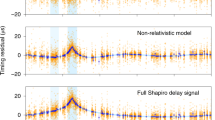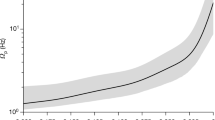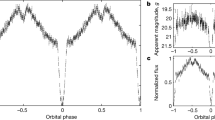Abstract
Binary pulsars provide an excellent system for testing general relativity because of their intrinsic rotational stability and the precision with which radio observations can be used to determine their orbital dynamics. Measurements of the rate of orbital decay of two pulsars have been shown1,2 to be consistent with the emission of gravitational waves as predicted by general relativity, but independent verification was not possible. Such verification can in principle be obtained by determining the orbital inclination in a binary pulsar system using only classical geometrical constraints. This would permit a measurement of the expected retardation of the pulse signal arising from the general relativistic curvature of space-time in the vicinity of the companion object (the ‘Shapiro delay’). Here we report high-precision radio observations of the binary millisecond pulsar PSR J0437-4715, which establish the three-dimensional structure of its orbit. We see the Shapiro delay predicted by general relativity, and we determine the mass of the neutron star and its white dwarf companion. The determination of such masses is necessary in order to understand the origin and evolution of neutron stars3.
This is a preview of subscription content, access via your institution
Access options
Subscribe to this journal
Receive 51 print issues and online access
$199.00 per year
only $3.90 per issue
Buy this article
- Purchase on Springer Link
- Instant access to full article PDF
Prices may be subject to local taxes which are calculated during checkout


Similar content being viewed by others
References
Taylor, J. H. & Weisberg, J. M. A new test of general relativity: Gravitational radiation and the binary pulsar PSR 1913+16. Astrophys. J. 253, 908–920 (1982).
Stairs, I. H. et al. Measurement of relativistic orbital decay in the PSR B1534+12 binary system. Astrophys. J. 505, 352–357 (1998).
Thorsett, S. E. & Chakrabarty, D. Neutron star mass measurements. I. Radio pulsars. Astrophys. J. 512, 288–299 (1999).
Johnston, S. et al. Discovery of a very bright, nearby binary millisecond pulsar. Nature 361, 613–615 (1993).
Bell, J. F., Bailes, M. & Bessell, M. S. Optical detection of the companion of the millisecond pulsar PSR J0437-4715. Nature 364, 603–605 (1993).
Danziger, I. J., Baade, D. & Della Valle, M. Optical spectroscopy and photometry of the companion of the bright millisecond pulsar PSR J0437-4715. Astron. Astrophys. 276, 382–388 (1993).
Kopeikin, S. M. On possible implications of orbital parallaxes of wide orbit binary pulsars and their measurability. Astrophys. J. 439, L5–L8 (1995).
Kopeikin, S. M. Proper motion of binary pulsars as a source of secular variation of orbital parameters. Astrophys. J. 467, L93–L95 (1996).
Sandhu, J. S. et al. The proper motion and parallax of PSR J0437-4715. Astrophys. J. 478, L95–L98 (1997).
Damour, T. & Taylor, J. H. On the orbital period change of the binary pulsar PSR 1913+16. Astrophys. J. 366, 501–511 (1991).
Cannon, W. H. et al. The S2 VLBI system. Vistas Astron. 41, 297–302 (1997).
van Straten, W., Bailes, M. & Britton, M. in Pulsar Astronomy—2000 and Beyond, IAU Colloq. 177 (eds Kramer, M., Wex, N. & Wielebinski, R.) 283–284 (Astron. Soc. Pacif. Conf. Series, San Francisco, 2000).
Taylor, J. H. Pulsar timing and relativistic gravity. Proc. R. Soc. Lond. A 341, 117–134 (1992).
Camilo, F., Foster, R. S. & Wolszczan, A. High-precision timing of PSR J1713+0747: Shapiro delay. Astrophys. J. 437, L39–L42 (1994).
Backer, D. C. The neutron star-helium white dwarf population in the galactic disc. Astrophys. J. 493, 873–878 (1998).
Bell, J. F. & Bailes, M. A new method for obtaining binary pulsar distances and its implications for tests of general relativity. Astrophys. J. 456, L33–L36 (1996).
McHugh, M. P., Zalamansky, G., Vernott, F. & Lantz, E. Pulsar timing and the upper limits on a gravitational wave background: A bayesian approach. Phys. Rev. D 54, 5993–6000 (1996).
Damour, T. & Deruelle, N. General relativistic celestial mechanics of binary systems. II. The post-Newtonian timing formula. Ann. Inst. H. Poincaré Phys. Théor. 44, 263–292 (1986).
Taam, R. E. & van den Heuvel, E. P. J. Magnetic field decay and the origin of neutron star binaries. Astrophys. J. 305, 235–245 (1986).
Acknowledgements
The Parkes Observatory is part of the Australia Telescope which is funded by the Commonwealth of Australia for operation as a National Facility managed by CSIRO. We thank the staff at Parkes Observatory for technical assistance and performance of regular observations. S.R.K. and S.B.A. thank NSF and NASA for supporting their work at Parkes. We also thank R. Edwards and M. Toscano for comments on the text. We received support from Compaq and the Space Geodynamics Laboratory of the Centre for Research in Earth and Space Technology. M. Bailes is an ARC Senior Research Fellow.
Author information
Authors and Affiliations
Corresponding author
Rights and permissions
About this article
Cite this article
van Straten, W., Bailes, M., Britton, M. et al. A test of general relativity from the three-dimensional orbital geometry of a binary pulsar. Nature 412, 158–160 (2001). https://doi.org/10.1038/35084015
Received:
Accepted:
Issue Date:
DOI: https://doi.org/10.1038/35084015
This article is cited by
-
Fermion pair radiation from accelerating classical systems
Journal of High Energy Physics (2023)
-
Can a regular black hole be observationally distinguished from singular black holes as spinning lens partner in PSR-BH binaries?
Journal of Astrophysics and Astronomy (2021)
-
Times of arrival (TOA) of signals in the Kerr-MOG black hole
General Relativity and Gravitation (2020)
-
PONDER - A Real time software backend for pulsar and IPS observations at the Ooty Radio Telescope
Experimental Astronomy (2015)
-
General relativistic spin-orbit and spin–spin effects on the motion of rotating particles in an external gravitational field
General Relativity and Gravitation (2012)
Comments
By submitting a comment you agree to abide by our Terms and Community Guidelines. If you find something abusive or that does not comply with our terms or guidelines please flag it as inappropriate.



